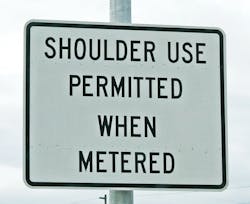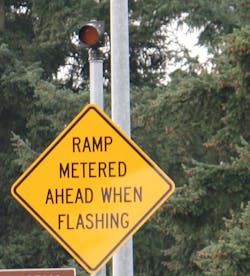A practical approach
Technology is central to all we do in transportation and its importance is only growing in our changing transportation landscape.
From roadway sensors to entire traffic management systems, technology has been key to both our urban and rural transportation systems for quite some time. As populations increase, we can no longer build our way out of congestion. Instead, we must use intelligent transportation system (ITS) technology and new ways of thinking to squeeze every ounce of efficient multimodal traffic operations out of existing systems. We also must simultaneously plan for the future.
Imagine, for example, being able to add nearly the equivalent of a full lane of capacity in one of your most congested and expensive urban areas. Rather than building a new lane, though, better transportation systems management and operations (TSMO) provide the same benefit at a fraction of the cost. An example is “peak-use shoulder lane running,” allowing vehicles to drive on the shoulder at certain times to create another lane, coupled with ramp meters, which control the flow of vehicles from ramps onto freeways. Together, these methods add capacity just when it is needed and also reduce collisions, improve traffic flow, and decrease travel times for commuters. In addition, the savings from avoiding a costly construction project can be spent on other needs throughout the system.
Investment in ITS technology is a central component of how we are managing traffic, providing traveler information and sharing information with our partners. Coupled with transportation demand strategies, it is also how we are planning to meet both near- and long-term needs.
Traffic management tactics such as peak-time shoulder use and metered expressway ramp access are aiding WSDOT’s overall congestion protocols.
Intelligent transportation systems
Our regional traffic management centers (TMC) are the nerve centers of our daily traffic operations activities as well as invaluable resources during emergency response. The Washington State Department of Transportation (WSDOT) operates six regional TMCs where real-time information is gathered 24 hours a day, seven days a week from traffic detectors, CCTV cameras and ramp meters, as well as through communication with the Washington State Patrol, road crews, WSDOT’s incident response teams and the media. We use this information to respond to incidents, deal with other problems that occur, and notify the public and the media about what is happening on the roads.
Tools in the TMC include:
- Active traffic management: Variable speed signs, arrows noting blocked lanes ahead, and overhead messaging improve safety and mobility during incidents, construction, maintenance, and peak commute times, without the need for costly roadway expansion;
- Traffic cameras: Our extensive statewide network of closed-circuit television helps our TMCs detect and quickly respond to congestion, incidents, and other problems on the roads. The camera images are available online for travelers, the media and the Washington State Patrol. Additionally, we manage a multi-agency, shared camera and traffic data network that allows all participants to view information from other agency systems in real-time;
- Variable message signs: These electronic signs provide travelers with information about traffic congestion, incidents, roadwork, travel times, special events or speed limits on the highway. They also may recommend alternative routes and share weather-related travel problems, emergency and disaster information, public service announcements, and emergency alerts (AMBER, Blue and Silver);
- Highway Advisory Radios (HAR): HARs are low-power AM radio stations along the roadway. They provide alerts and general traffic and travel information;
- Road Weather Information Systems (RWIS): RWIS stations installed along the roadway gather details about weather and road surface conditions, measuring air and road surface temperatures, barometric pressure, humidity, wind, precipitation, and visibility. This information helps drive maintenance decisions and provides information to travelers;
- Ramp meters: An adaptive ramp meter system for freeway on-ramps controls the flow of vehicles entering the freeway mainline. Activation and metering rates are adjusted automatically by the system, based on prevailing freeway traffic conditions. Bypass lanes for transit and other high-occupancy vehicles reduce trip times and encourage mode choice; and
- Traffic data collectors: Traffic detectors are one of the key sets of tools used to keep track of what is happening on the roadways. Detection data is used to operate traffic signals, ramp meters and travel-time signs. Data also is sent from the roadside to the TMCs to monitor operations and provide traffic conditions to the website and the WSDOT 511 traffic information hotline.
We combine our technology tools with proven tactics to maximize efficiency, as well as address safety and travel-time reliability:
- Our variable speed-limit signs allow us to decrease speeds due to incidents, congestion or treacherous weather, giving drivers real-time information about conditions and a chance to slow down and reduce collisions;
- High-occupancy toll (HOT) lanes and express toll lanes manage demand, provide corridors for high-capacity transit, and create opportunities to purchase a more reliable travel time while also creating a revenue stream to offset some of the ongoing operation and maintenance costs; and
- Adaptive lighting allows us to turn lighting up or down as needed, conserving resources and the environment during low-need times.
We also design our ITS and communications systems with multiple backups and redundancies to ensure resiliency during disasters and other emergency events. During a large earthquake, for example, ITS systems will be crucial in gathering information about damaged infrastructure as well as developing and sharing response, repair and alternate route details.
“Practical solutions”
We need to do more than just invest in technology, however. We need to be smart and strategic about where and when we make these investments, balancing resources so we make the right investment, at the right place, at the right time.
Those decisions must be aimed at maintaining a state of good repair and maximizing the effectiveness of current infrastructure. We also need dedicated support and funding to maintain each infrastructure investment. In addition, we must consider the needs of all users and modes when making investment decisions. We also need to scale our work, adding only what is needed short-term while aligning that work with future long-term plans.
For example, WSDOT owns approximately $1 billion (in replacement costs) worth of major electrical systems, which include a hefty price tag for life-cycle preservation and replacement. Those costs, though, assume we need everything in its current form. Given budget constraints and ever-changing technology advances, we must strategically assess exactly which assets help preserve the intended function and system performance.
We make these needed strategic investment decisions by using a systemic “Practical Solutions” approach. Practical Solutions relies on data-driven decision-making rather than doing things as they have always been done in the past. This includes considering all modes of transportation in our work, but also prioritizing the biggest return on investment in some instances. Moreover, given the return on investment that ITS and TSMO provide, we must identify those strategies and options first before moving on to traditional capital improvements.
A recent example of our Practical Solutions approach is our new approach to lighting. As maintenance and utility costs rose, we researched the use of light on our roadways and learned that, in many cases, we were providing more lighting than was needed to maintain safety. Due to our new findings, we changed our roadway lighting design policy, focusing on the minimal level of lighting needed for safety and then “justifying up” additional lighting in specific locations. (Merge and diverge points, for example, remain lighting priorities.) The new guidelines also consider other safety measures, such as enhanced signing and striping, before additional lighting is included in designs.
This research and new approach allowed us to remove lighting that was no longer adding value (505 lights and poles statewide) while also replacing the remaining lights (2,162) with more efficient and brighter LED lights—as well as incorporating adaptive light features. In addition, we used our agency’s first Energy Savings Performance Contract to do the work—with energy savings covering the bond payments—and used a Google map rather than traditional plan sheets during project delivery.
We are building on the success of Phase 1 with a much larger project with the same philosophy: Remove lights that are no longer needed while converting the remainder to LED. The goal is to convert 12,000 lights to LED and remove 4,000 WSDOT-owned lights statewide over a four- to six-year period.
The future
As we continue to assess our current technology, we also must prepare for the future of transportation, which could look very different than today. Cooperative automated transportation, including connected and autonomous vehicles, brings the possibility of exciting safety, congestion and greenhouse-gas reduction improvements, but it will also profoundly change both how people travel and the needs of roadway and traffic operations systems.
Our current system focuses on automobiles and the behavior of human drivers, and must account for driver error and poor behavior. Soon, as an interim step, we may need systems and infrastructure that interact with connected and autonomous vehicles, as well as relaying information to drivers. Ultimately, a cooperative automated transportation system will give users of our system a suite of transportation choices—driving, shared mobility, public transportation, active transportation (and in Washington State, taking the ferry)—to meet their mobility needs.
This change in direction could mean removing or repurposing some existing systems as needs evolve. We also will need new training at our universities, new and different career development within our agencies and more public-private partnerships to possibly transfer some traditional duties (e.g., traveler information or roadway weather information) to the private sector.
There are exciting developments ahead in our state and national transportation system, but we must be prepared for these changes today while remaining flexible enough to adapt to new needs and opportunities as they develop.



